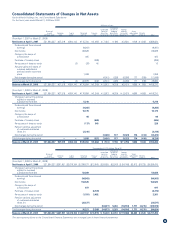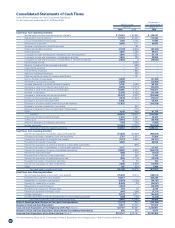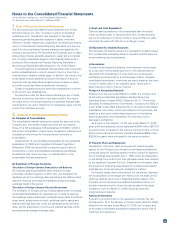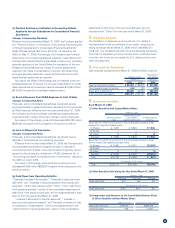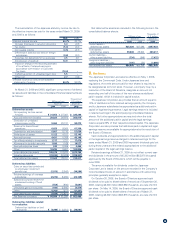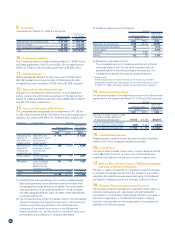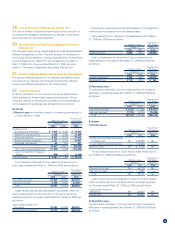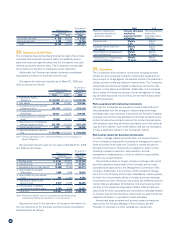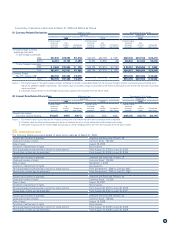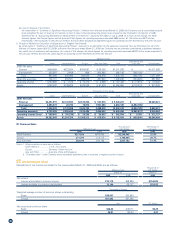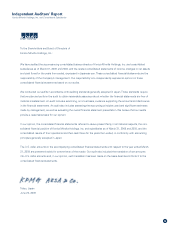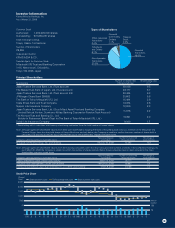Konica Minolta 2009 Annual Report Download - page 42
Download and view the complete annual report
Please find page 42 of the 2009 Konica Minolta annual report below. You can navigate through the pages in the report by either clicking on the pages listed below, or by using the keyword search tool below to find specific information within the annual report.
40
Millions of yen
Thousands of
U.S. dollars
March 31 March 31
2009 2008 2009
Due within one year ¥ 920 ¥2,238 $ 9,366
Due over one year 1,189 3,420 12,104
Total ¥2,109 ¥5,658 $21,470
23. Retirement Benefit Plans
The Companies have defined benefit retirement plans that include
corporate defined benefit pensions plans, tax-qualified pension
plans and lump-sum payment plans and the Companies have also
defined contibutory pension plans. The Companies may pay addi-
tional retirement benefits to employees at their discretion.
Additionally, the Company and certain domestic consolidated
subsidiaries contribute to retirement benefit trust.
The reserve for retirement benefits as of March 31, 2009 and
2008 is analyzed as follows:
Millions of yen
Thousands of
U.S. dollars
March 31 March 31
2009 2008 2009
a. Retirement benefit
obligations ¥(140,843) ¥(144,011) $(1,433,808)
b. Plan assets 74,124 91,360 754,596
c. Unfunded retirement benefit
obligations (a+b) (66,718) (52,651) (679,202)
d. Unrecognized actuarial
differences 18,621 10,276 189,565
e. Unrecognized prior service
costs (7,033) (8,131) (71,597)
f. Net amount on consolidated
balance sheets (c+d+e) (55,130) (50,506) (561,234)
g. Prepaid pension costs 2,831 2,861 28,820
h. Accrued retirement benefits
(f-g) ¥ (57,962) ¥ (53,367) $ (590,064)
Note: Certain subsidiaries use a simplified method for the calculation of
benefit obligation.
Net retirement benefit costs for the years ended March 31, 2009
and 2008 are as follows:
Millions of yen
Thousands of
U.S. dollars
March 31 March 31
2009 2008 2009
a. Service costs ¥ 5,181 ¥ 5,662 $ 52,744
b. Interest costs 4,074 4,410 41,474
c. Expected return on plan assets (2,280) (3,095) (23,211)
d. Amortization of actuarial
differences 1,860 1,248 18,935
e. Amortization of prior service
costs 643 (1,426) 6,546
f. Retirement benefit costs
(a+b+c+d+e) 9,479 6,799 96,498
g. Contributions to defined
contribution pension plans 3,168 3,199 32,251
Total (f+g) ¥12,647 ¥ 9,998 $128,749
Note: Retirement benefit costs of consolidated subsidiaries using
a simplified method are included in “a. Service costs”.
Assumptions used in the calculation of the above information for
the main schemes of the Company and its domestic consolidated
subsidiaries are as follows:
2009 2008
Method of attributing
retirement benefits to
periods of service
Periodic allocation
method for
projected benefit
obligations
Periodic alloca tion
method for
projected bene fit
obligations
Discount rate Mainly
2.5%
Mainly
2.5%
Expected rate of return on
plan assets
Mainly
1.25%
Mainly
1.25%
Amortization of unrecognized
prior service cost
Mainly
10 years
Mainly
10 years
Amortization of unrecognized
actuarial differences
Mainly
10 years
Mainly
10 years
24. Derivatives
The Companies utilize derivative instruments including forward
foreign currency exchange contracts, interest rate swaps and cur-
rency swaps, to hedge against the adverse effects of fluctuations in
foreign currency exchange rates and interest rates. The Companies
utilize these derivatives as hedges to effectively reduce the risks
inherent in their assets and liabilities. Additionally, the Companies
have a policy of limiting the purpose of such transactions to hedg-
ing identified exposures only and they are not held for speculative
or trading purposes.
Risks associated with derivative instruments
Although the Companies are exposed to credit-related risks and
risks associated with the changes in interest rates and foreign
exchange rates, such derivative instruments are limited to hedging
purposes only and the risks associated with these transactions are
limited. All derivative contracts entered into by the Companies are
with selected major financial institutions based upon their credit rat-
ings and other factors. Such credit-related risks are not anticipated
to have a significant impact on the Companies’ results.
Risk control system for derivative instruments
In order to manage market and credit risks, the Finance Division
of the Company is responsible for setting or managing the position
limits and credit limits under the Company’s internal poli cies for
derivative instruments. Resources are assigned to each function,
including transaction execution, administration, and risk
management, independently, in order to clarify the responsibility
and the role of each function.
The principal policies on foreign currency exchange instruments
and other derivative instruments of the Company and its major
subsidiaries are approved by the Management Committee of the
Company. Additionally, a Committee, which consists of manage-
ment from the Company and its major subsidiaries, meets regularly,
at which time the principal policies on foreign currency exchange
instruments and other derivative instruments are reaffirmed and the
market risks are assessed. All derivative instruments are reported
monthly to the respective responsible officers. Market risks and
credit risks for other subsidiaries are controlled and assessed based
on internal rules and the derivative instruments are approved by the
respective President or equivalent of each subsidiary.
Interest rate swap contracts and currency swap contracts are
approved by the Finance Manager of the Company and the
President or equivalent of other subsidiaries, respectively.



